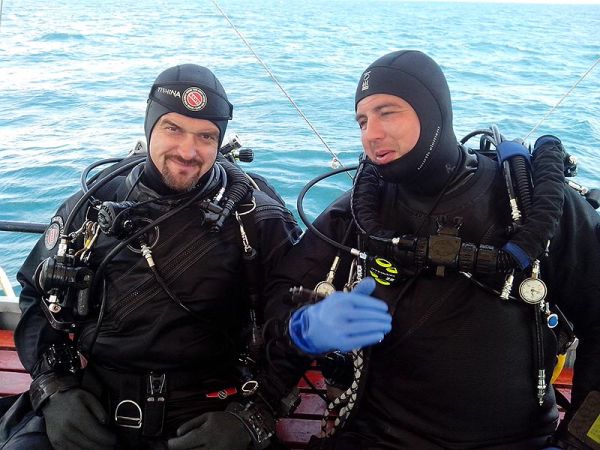Russian President Vladimir Putin's visit to the site of the underwater archaeological expedition
The underwater-archaeological mission of the Institute of Oriental Studies of the Russian Academy of Sciences has been conducting research in the waters of the city of Sevastopol off the coast of the Crimean Peninsula since 1999.
The expedition leader is an employee of the Institute, PhD. V.V. Lebedinsky.
During this time, conducted a unique research work. In its studies, the Institute of Oriental Studies of the Russian Academy of Sciences collaborates with various scientific and public organizations: Sevastopol State University, State Historical and Archeological Museum-Reserve “Chersonese Tavrichesky”, Sevastopol Branch of the Russian Geographical Society, Ministry of Defense of the Russian Federation. As a result of the research, unique scientific results were obtained. Discovered shipwrecks of the ancient and medieval periods. For example, a shipwreck was found on a Byzantine period of the 10th century. at the western Cape of the Round Bay, fragments of amphorae protruding from the ground ship structures were found on the sea bottom, an iron anchor was raised. A similar object, dated to the 7th – 10th centuries, was found at Cape Malchin. A ceramic material, two iron anchors of the same type, is found on the seabed.
Studies have been carried out on the abrasion of the coastline of Chersonese and its choirs. The ancient coastline of the ancient settlement itself was restored and a 3D model of the historical landscape of the agricultural region, Chersonesus choirs, was created. These studies made it possible to present the real dimensions of the ancient city, reconstruct land plots - clamers, calculate the destruction of the Chersonesus ancient settlement in dynamics. For example, the northeast coast of Chersonesos loses 2.3–2.5 m per century, i.e. at the turn of the new era, the coast was located 45–50 m more seaward than the modern one.

|

|

|

|

|

|
In 2015, a unique object was found and examined - a shipwreck of a Byzantine vessel of the 10th-11th centuries. AD at Balaclava. At a depth of 83 meters, as a result of reconnaissance using side-scan sonar, a cluster of amphoras was found, well-preserved parts of the ship's structures. Unique deep-sea research has been conducted. The marking of the shipwreck site was made, the photogrammetry method made up of hundreds of images made the general plan of the detected object. The material was fixed in two squares and five amphoras of the upper layer were lifted to the surface for transfer to the museum and subsequent study by ceramics specialists. The study of ceramic material and the contents of the raised amphorae made it possible to date the find and restore the last route of the vessel. Most likely, it was a merchant ship sailing from the shores of Asia Minor, from the region of Constantinople, to Cape Sarich and further to Kherson. The cargo of the ship consisted of amphoras filled with wine. The fact that it was wine that was transported in amphorae was suggested by a cork made of pine bark with a hole, found in one of the vessels. The upper layer of the monument contains about 250 whole amphoras and their large fragments. In total, the vessel was transported, probably up to 500 vessels. Work on this unique facility continues. In August 2015, the site of research was visited by the President of Russia V.V. Putin
In 2012-2016 a sonar survey of the water area of the city of Sevastopol was conducted, hundreds of underwater objects of artificial origin were identified. Many of them are of scientific interest, a digital database of the detected objects was compiled. Geophysical studies of the seabed adjacent to the so-called “port area” of Chersonesos were also conducted.
In 2017-2018 at the mouth of the river Belbek, iron anchors dating from the Roman period of the II-III centuries were found and raised. AD, and also lead objects - a boiler and two ingots. The depth of the objects and their character suggest that the crash site of the Roman period was discovered.
One of the objects found is located in the very center of the Sevastopol bay opposite the monument to the Scuttled Ships.

In the course of underwater archaeological research, a project was proposed for an innovative complex of visualization, museumification and preservation of underwater archaeological objects. The concept of marine exposition for the State Museum Reserve "Chersonese Tauride"was developed.
According to the results of research, scientific articles and monographs were written, documentaries were made.
Together with the Russian Geographical Society and the Ministry of Defense of the Russian Federation, searches were carried out and, after its discovery, a survey of the Prut Ministry of Public Health, who died in a battle with the German-Turkish cruiser Goeben. This legendary ship, which was called the "Black Sea Varyag", died in October 1914 at the Black Sea theater of military operations with Turkey in the Great War.
Currently, the Institute of Oriental Studies of the Russian Academy of Sciences, in conjunction with the Sevastopol State University and the Ministry of Defense of the Russian Federation, are planning to conduct underwater archaeological research in the waters of the city of Sevastopol using remotely controlled unmanned underwater vehicles at great depths, which will open new, well-preserved underwater archaeological objects on seabed.